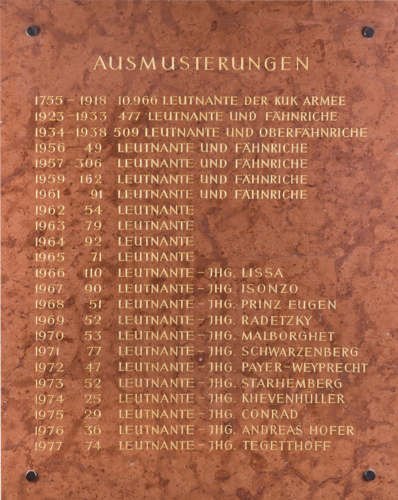"Competent Officers"
16.881 young men - and since 1999 also women - have been trained as officers at the Military Academy to date.
Be it for the imperial army or for the imperial and royal army, the Armed Forces of the 1st Republic or, since 1956, today's Armed Forces - they have all been trained and educated as "competent and righteous officers" in accordance with Maria Theresia's basic mission. They are all united by the "Neustadt spirit".
On 3 February 1956, the first officers of the army of the 2nd Republic, the "A-class", were decommissioned.
The members of the "E-class" had a prior appointment with the police or gendarmerie. They received a shortened training and were therefore already retired at the end of 1957. There was therefore no graduation in 1958.
With the "Curriculum 1958", the duration of officer training was fixed at a total of four years, three of them at the military academy. In 1960 there was therefore no graduation either.
Since 1966, the classes have borne names that recall well-known persons, events or theatres of war in Austria's military history. This idea was first put into practice by the 1966 class and goes back to the visit of a delegation from the Theresian Military Academy to the French Academy, the Military School Saint-Cyr, in 1964, where this tradition has existed for some time.
With the recognition of the Bachelor Programme "Military Leadership" by the School of Applied Sciences Council on 29 July 1997, the training of military officers was also extended to four years. In 1999, therefore, no graduation took place. The first class affected by this system change was the class "Monte Piano".
In 2008, there were changes in the content and timing of military officer training due to the adjustments to the Europe-wide harmonisation of study programmes (Bologna Process). The training period was again reduced to three years. In 2011, therefore, two classes graduated- the class "Ritter von Lehmann" trained according to the four-year model and the class "Freiherr von Lehar" according to the three-year model.


